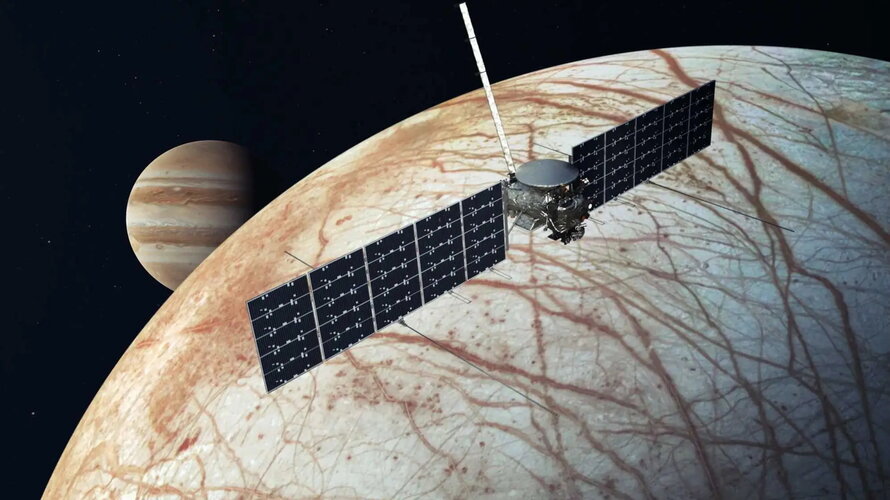SpaceX wins earlier-than-expected approval to fly fifth Starship
Monday, 14 October 2024 11:30This request seems a bit unusual, so we just need to confirm you're human. Please complete the slider CAPTCHA by dragging it to the right. Thank you for your understanding!
If you believe this is an error, please contact our support team.
185.132.36.159 : 9bc207b7-d5de-418c-9d33-dfd9b971
Zero Debris Charter goes intercontinental
Monday, 14 October 2024 11:02 Image:
Zero Debris Charter goes intercontinental
Image:
Zero Debris Charter goes intercontinental In milestone, SpaceX 'catches' megarocket booster after test flight
Monday, 14 October 2024 10:59 SpaceX on Sunday successfully flew the first-stage booster of its Starship megarocket back to the launch pad after a test flight, a technical tour de force that furthers the company's quest for rapid reusability.
The "super heavy booster" had blasted off attached to the uncrewed Starship rocket minutes earlier, then made a picture-perfect controlled return to the same pad in Texas, where a p
SpaceX on Sunday successfully flew the first-stage booster of its Starship megarocket back to the launch pad after a test flight, a technical tour de force that furthers the company's quest for rapid reusability.
The "super heavy booster" had blasted off attached to the uncrewed Starship rocket minutes earlier, then made a picture-perfect controlled return to the same pad in Texas, where a p Navigation tech for the future of mobility
Monday, 14 October 2024 10:49
Where would we be without our GNSS-enabled car navigation systems or navigation apps on our smartphone? Space technology, particularly global navigation satellite systems like the European Galileo, is the backbone of today's mobility and transport.
But are current technologies and systems enough to meet the evolving mobility needs of the future? The European Space Agency is closely monitoring emerging technology trends and staying ahead of the curve, designing and developing the future of Galileo and EGNOS, and conceiving new missions and programmes so that European space technology continues to serve the demands of an increasingly interconnected and mobile world.
ESA to build first in-orbit servicing mission with D-Orbit
Monday, 14 October 2024 09:30
ESA has taken another important step on the road towards sustainability in space with its first in-orbit servicing mission RISE. A €119 million contract was signed with D-Orbit as the co-funding prime contractor.
Living Planet Symposium 2025: time for abstracts
Monday, 14 October 2024 09:00
ESA’s Living Planet Symposium 2025 will take place from 23–27 June 2025 at the Austria Center Vienna, Austria. As this prestigious event approaches, now is the time to submit your abstracts for a chance to present your research on topics related to Earth observation from space, with a special focus on the theme: From Observation to Climate Action and Sustainability for Earth.
Hera’s first images offer parting glimpse of Earth and Moon
Monday, 14 October 2024 07:30
ESA’s Hera mission for planetary defence has taken its first images using three of the instruments that will be used to explore and study the asteroids Dimorphos and Didymos.
French startup gets state-backed seed funds for VLEO broadband constellation
Monday, 14 October 2024 06:00

Juice and Europa Clipper: Dream team to Jupiter
Monday, 14 October 2024 06:00
What’s better than one spacecraft on the quest to search for life-friendly ocean worlds in the Jupiter system? Two! ESA’s Jupiter Icy Moons Explorer (Juice) is set to join forces with NASA’s Europa Clipper – launched on 14 October – to tackle one of the biggest questions in Solar System science.
In a first, SpaceX 'catches' megarocket booster after test flight
Monday, 14 October 2024 00:15 SpaceX successfully "caught" the first-stage booster of its Starship megarocket Sunday as it returned to the launch pad after a test flight, a world first in the company's quest for rapid reusability.
The "super heavy booster" had blasted off attached to the Starship rocket minutes earlier, then made a picture-perfect controlled return to the same pad in Texas, where a pair of huge mechanica
SpaceX successfully "caught" the first-stage booster of its Starship megarocket Sunday as it returned to the launch pad after a test flight, a world first in the company's quest for rapid reusability.
The "super heavy booster" had blasted off attached to the Starship rocket minutes earlier, then made a picture-perfect controlled return to the same pad in Texas, where a pair of huge mechanica Space-made aluminium weld analyzed at ESA lab
Monday, 14 October 2024 00:15 ESA engineers have closely examined an aluminium weld produced in space, marking a historic achievement as the first autonomous welding conducted in orbit, and the first of its kind involving ESA. The weld, just one centimeter in size, was produced using electron beam welding during an experiment initiated by ThinkOrbital, a US startup.
This weld, created aboard a spacecraft launched via a
ESA engineers have closely examined an aluminium weld produced in space, marking a historic achievement as the first autonomous welding conducted in orbit, and the first of its kind involving ESA. The weld, just one centimeter in size, was produced using electron beam welding during an experiment initiated by ThinkOrbital, a US startup.
This weld, created aboard a spacecraft launched via a Parry Labs wins contract from US Space Force to modernize digital spaceports
Monday, 14 October 2024 00:15 Parry Labs has secured a Direct to Phase II Small Business Innovation Research (SBIR) contract from the U.S. Space Force (USSF) as part of its "Digital Spaceport of the Future" challenge. This initiative focuses on enhancing spaceport operations with cutting-edge digital solutions.
Out of over 150 submitted proposals, Parry Labs was one of 12 companies chosen for this contract, issued thro
Parry Labs has secured a Direct to Phase II Small Business Innovation Research (SBIR) contract from the U.S. Space Force (USSF) as part of its "Digital Spaceport of the Future" challenge. This initiative focuses on enhancing spaceport operations with cutting-edge digital solutions.
Out of over 150 submitted proposals, Parry Labs was one of 12 companies chosen for this contract, issued thro 




